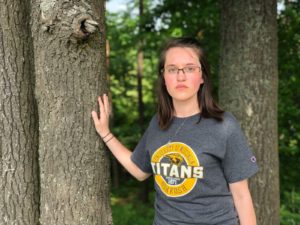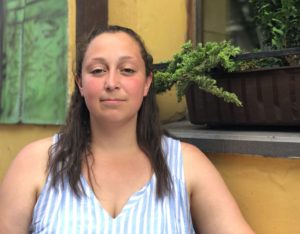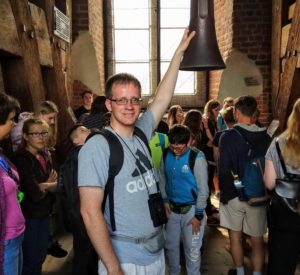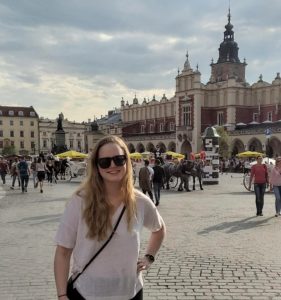 My name is Ellen and I’m a double major in History and Anthropology with a focus on the Holocaust at UW-Oshkosh. The majority of my studies have been on the three extermination centers Sobibór, Treblinka, and Belżec. Today our group visited the Majdanek concentration camp and the memorial of the Belżec extermination center.
My name is Ellen and I’m a double major in History and Anthropology with a focus on the Holocaust at UW-Oshkosh. The majority of my studies have been on the three extermination centers Sobibór, Treblinka, and Belżec. Today our group visited the Majdanek concentration camp and the memorial of the Belżec extermination center.
When we went to Majdanek, I had a similar feeling to when we went through Auschwitz. At Auschwitz, you could feel the pain and suffering that occurred there. At Majdanek, with everything intact, I felt even more overwhelmed. Walking through the gas chambers and seeing the residue of the Zyklon B gas along with scratches on the walls made it feel as if you yourself were there. The whole time, I was wondering how something as horrific as the Holocaust could have happened. I continually asked myself how the victims could have the strength to hold on and to keep fighting for their lives.
Some of the barracks were transformed into displays showing various different information. Some showed the sequence of events, what cities and towns people were from that were sent to Majdanek, as well as a very touching and emotional memorial. Within this memorial they had stones and lanterns laid out and a book that listed all of the nationalities of the people who were victims there.
When we arrived at Belżec, I wasn’t sure what to expect knowing that the actual extermination center had been demolished. Once we got there and started to walk down the path between the two halves of the memorial, you could feel the impact. The walls kept getting higher and it felt as if they were closing in on you. The quote that was carved into the wall couldn’t have been more appropriate, it stated “earth do not cover my blood, let there be no resting place for my outcry.” It shows that no matter how much time has passed you can never cover up the events and lives that were taken there. I was amazed by how the memorial itself was set up.
When entering into the museum I had the opportunity to talk to a worker there and she explained all of the symbolism behind the memorial. The front walls towards the entrance represent the train tracks and where the transports stopped. The center stone that is at an angel represents the entrance of the extermination camp and is positioned between the two walk ways to form the Star of David. The lava rocks represented the ashes of the victims and the darker stone locations represent where the mass graves were located. The trees represented the demolishing of the extermination center and the final silent witnesses of the atrocities that took place there. The way the memorial is set up is incredible and has so much power.
Going to Majdanek and Belźec today reminded me of why I wanted to study the Holocaust. To keep the memory alive and to educate people on what happened, so that it doesn’t happen again. To remind people that no matter what you go through, your life is worth fighting for.
– Ellen Dodge, UW-Oshkosh
 Today we had to wake up early and get on a bus to Lublin. After being out enjoying the nightlife and getting an early morning snack from KFC, many of us were tired from the late night. After settling in on the bus with all of our belongings, many people drifted off to sleep on our drive through the countryside. For those that stayed awake, our guide tried teaching us some simple but important Polish phrases which we all butchered. About halfway through our drive, we stopped to see the memorial in Tarnow. The memorial, named Zbylitowska Góra, represents the mass murder that occurred in 1941. During this mass murder, the Nazis marched Jews and Poles out into the woods where adults were shot and children had theirs heads bashed in with the butt of their guns to save bullets. The memorial is a giant monument acknowledging the tragedy that occurred on that day. Behind the monument is a path through the woods with sections marked off by fences where they believe the different mass graves are located in that small area. After spending some time at the memorial letting yet another of the atrocities from the Holocaust sink in, we got back on the bus and continued our drive. After sitting on the bus and reflecting on what I had saw in Tarnow, I still have no words to describe my feelings about the mass murder. I cannot understand why or how so many people were able and willing to carry out these acts on people who are really no different than anyone else.
Today we had to wake up early and get on a bus to Lublin. After being out enjoying the nightlife and getting an early morning snack from KFC, many of us were tired from the late night. After settling in on the bus with all of our belongings, many people drifted off to sleep on our drive through the countryside. For those that stayed awake, our guide tried teaching us some simple but important Polish phrases which we all butchered. About halfway through our drive, we stopped to see the memorial in Tarnow. The memorial, named Zbylitowska Góra, represents the mass murder that occurred in 1941. During this mass murder, the Nazis marched Jews and Poles out into the woods where adults were shot and children had theirs heads bashed in with the butt of their guns to save bullets. The memorial is a giant monument acknowledging the tragedy that occurred on that day. Behind the monument is a path through the woods with sections marked off by fences where they believe the different mass graves are located in that small area. After spending some time at the memorial letting yet another of the atrocities from the Holocaust sink in, we got back on the bus and continued our drive. After sitting on the bus and reflecting on what I had saw in Tarnow, I still have no words to describe my feelings about the mass murder. I cannot understand why or how so many people were able and willing to carry out these acts on people who are really no different than anyone else.
When we finally got to Lublin, we dropped our bags off at the hotel and continued on into the city where we met our tour guide at the Grodzka Gate. The gate separates the Christian, Old Town section of Lublin from the Jewish section where the Polish King Casimir III, had granted them permission to settle around the Lublin Castle. Before World War II, there was a large population of Jews living in the area around the castle with a large synagogue that could hold over 3,000 men at a time. During and after the war, most of the area including the synagogue was destroyed. Grodzka Gate housed a theater for many years and is now a museum and archive detailing the history of the Jewish section of the town and all the people who lived there. After leaving the gate, we went to Lublin Castle. The castle has been rebuilt multiple times and was even used as a prison in the 19th Century. Within the castle is the royal chapel that contained both Catholic and Orthodox frescoes. The chapel was supposed to be Catholic but had a few Orthodox frescoes and other elements. It was very interesting to see the mix of these two different parts of Christianity. One interesting thing our guide pointed out is that some of the scratched writing on the walls was actually 17th century graffiti. While many things have changed since then, one thing that hasn’t is that people will still carve their names into things they probably shouldn’t. We left the castle and went to the old town for lunch. While walking around we found a building that had a new level added every century starting in the 14th century and was finally completed in 1954. After the experience I’ve had today I’m excited to see what the next few days in Lublin has in store for myself and the entire group!
– Megan Robertson, UW-Oshkosh
 Today we started off by going to Oskar Schindler’s Factory, made famous by the movie Schindler’s List. It has been made into an interactive museum profiling the experience of Jewish families at the time of the Holocaust. The experience of walking through the museum was nothing short of amazing. The creators of the museum clearly put a lot of thought into its presentation They produced it in a way that allows you to experience and understand the depth of the tragedy of the Holocaust.
Today we started off by going to Oskar Schindler’s Factory, made famous by the movie Schindler’s List. It has been made into an interactive museum profiling the experience of Jewish families at the time of the Holocaust. The experience of walking through the museum was nothing short of amazing. The creators of the museum clearly put a lot of thought into its presentation They produced it in a way that allows you to experience and understand the depth of the tragedy of the Holocaust.
Next we went to Auschwitz I. Auschwitz is probably the most well-known Nazi death camp, just outside of Krakow. It was divided into two pieces. Auschwitz I was an old army base that became a concentration camp. Auschwitz-Berkinau was a death camp. Upon arriving we were greeted by our wonderful tour guide. First, she gave us an overview of the layout. Then we walked through the barrack. Each one had a different theme. One of them focused on the physical evidence, such as hair, shoes, and clothes. I was especially moved by the exhibit that had pounds and pounds of hair that was cut off of the Jew’s heads. It was so much hair and it belonged to someone before it was cut off. It was overwhelming to see the shoes, pots and pans, brushes, and children’s clothes. It helped to really demonstrate that each person who died there had a name, a family, a home, and a story. Another barrack that displayed all of the ways individuals were punished within the camp. Examples include starvation, lack of oxygen, and isolation. The last thing we did at Auschwitz I was walk through the gas chamber and crematorium. This by far was the hardest part to handle emotionally. Learning and talking about the gas chambers is hard, but to walk through and run your hand across the wall where innocent people scratched to try to get out, is a totally different experience. After walking through that, we all felt emotional, and it was difficult to process.
After Auschwitz I, we went to Auschwitz-Birkenau. I was surprised by how large it was, and how much of it was destroyed. One thing that I found disturbing is the vandalism that has taken place in one of the barracks that was available to the public. People have etched their names and other terms on the bricks that it is made up of. It is important to remember that even though it looks like an empty building now, at one point it is where scared, innocent people had to stay. Overall, I am grateful to be able to see both Auschwitz locations. It is important to remember that “those who do not remember the past are doomed to repeat it.”
– Erica Micele, UW-Oshkosh
On Wednesday, May 23, 2018, the study abroad group and I continued on our 2nd day in  Krakow. We visited the Wawel Castle where we learned about its history and what life was like for those who lived there. In addition, we learned about how Poland honors its national heroes and patriots including those who fought in the American Revolution as well as in the Polish resistance during WWII. I was amazed and intrigued by how former Polish leaders, priests, and bishops were entombed with magnificent coffins lined with wood or stone engravings, as well as their continued reverence among Poles.
Krakow. We visited the Wawel Castle where we learned about its history and what life was like for those who lived there. In addition, we learned about how Poland honors its national heroes and patriots including those who fought in the American Revolution as well as in the Polish resistance during WWII. I was amazed and intrigued by how former Polish leaders, priests, and bishops were entombed with magnificent coffins lined with wood or stone engravings, as well as their continued reverence among Poles.
After visiting the castle, we visited the Jewish Quarter of Krakow. We stopped at the Jewish Community Center and spoke with a representative of the Krakow JCC, an American expatriate named Jennifer. She told us the origin story of the Center and how Prince Charles came to Krakow and asked the local residents what they needed. The response of these residents, including Holocaust survivors, was that they just wanted a place for their community to gather. After much effort, the JCC was established and exists as a place for Jews living in Krakow to come and be a community. It provides educational services for children and even those curious about Judaism. As of 2018, the Center has helped revive the Jewish community in Krakow and can possibly help the Jewish population of Poland and elsewhere engage in the communities in which they are a part of.
Finally, we visited several synagogues that, within the past 20 years, have been restored and renovated after decades of neglect and desecration. We learned how the synagogues were founded and what their significance was within the community as well as, unfortunately, how they were used by the Nazis during the occupation of Poland during WWII. After seeing the synagogues we visited a memorial dedicated to those who died with the liquidation of the Krakow Ghetto and subsequent deportation to Auschwitz. The memorial was a series of chairs spread out over a square in Krakow. It was to symbolize how during the liquidation, Jews were forced to stand or crouch and were not allowed to sit or lay down while waiting for the train to take them to Auschwitz or other death camps. They risked being shot if they did. Our local guide pointed out that while it is good that the Jewish community and the city of Krakow is trying to move on from its past, it is important to not forget what happened. I agree with our guide’s assessment that if we do not remember what happened or ignore it, we run the risk of repeating the Holocaust again. But as the Holocaust is being taught, re-taught, and discussed on a regular basis, the chances of it happening again are lowered, but it takes constant vigilance in order to prevent it from occurring again.
– Mike Miller, UW-Oshkosh
 My name is Colleen Huston and I am a double major in History and International Studies and my emphasis of study is in European conflict. I have always had a deep desire to learn about and eradicate human rights abuses, and in moving towards graduation this fall I hope to be able to apply that passion to my professional life. I was excited to take this trip because I knew that by being on the ground and seeing the environments that created and appropriated horrible acts of murder, I could better understand what steps lead the international community to the Holocaust and its aftermath.
My name is Colleen Huston and I am a double major in History and International Studies and my emphasis of study is in European conflict. I have always had a deep desire to learn about and eradicate human rights abuses, and in moving towards graduation this fall I hope to be able to apply that passion to my professional life. I was excited to take this trip because I knew that by being on the ground and seeing the environments that created and appropriated horrible acts of murder, I could better understand what steps lead the international community to the Holocaust and its aftermath.
Today, straight off of the plane, we focused on the aftermath of the Holocaust by looking at the Soviet history of Poland. We walked through the Socialist Realist community of Nowa Huta here in Krakow. It is the northernmost district in Krakow and houses many different sights to see including the PRL Museum which examines Poland under communist rule and looks extensively at the culture of nuclear sensitivities in the region. The expansive route of nuclear fallout shelters was really interesting to me and many other people on the trip, but after that museum we kept walking to see the parks all around the water and ended the first part of our day.
After a well deserved break, we were given the opportunity to go out on our own and eat lunch in small groups. After lunch we saw a tour of the old town of Krakow and got to see important buildings that have been there since the buildings were first erected, and it gave us a clearer understanding of what past as lead to Poland’s future and present day. I am excited for the rest of the trip and what it will entail as I have only been here for a day and have already learned so much!
– Colleen Huston, UW-Oshkosh